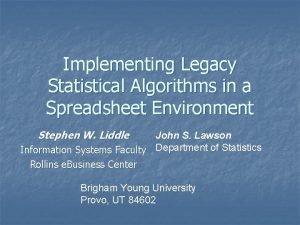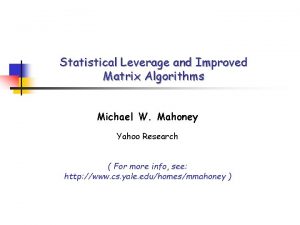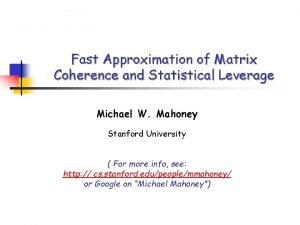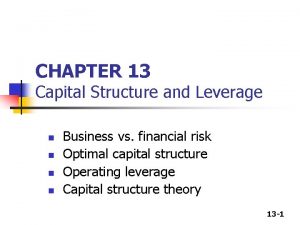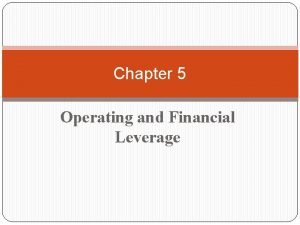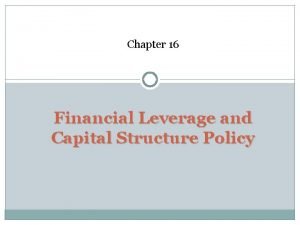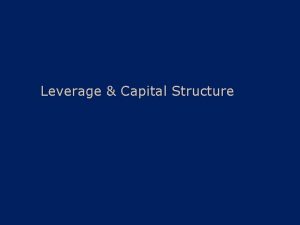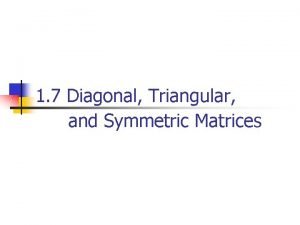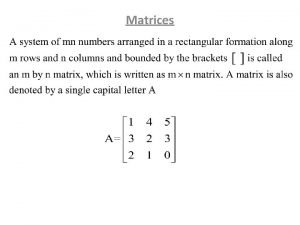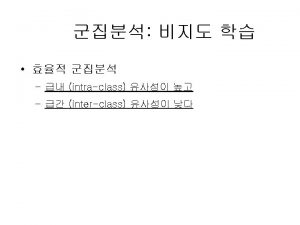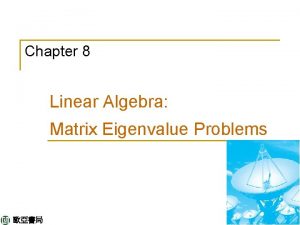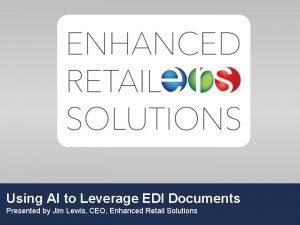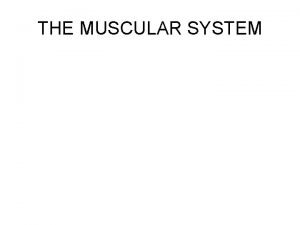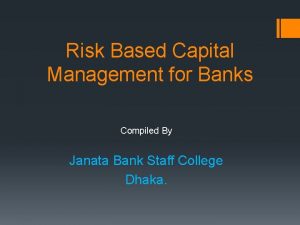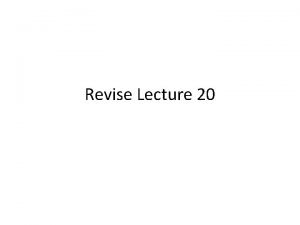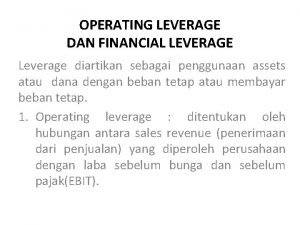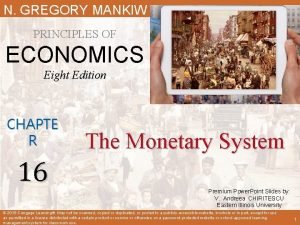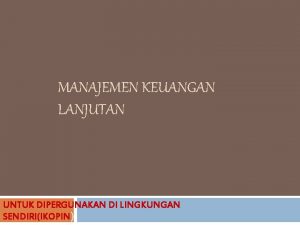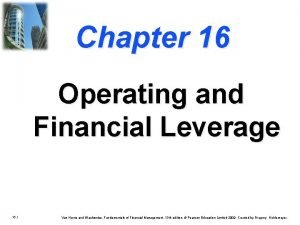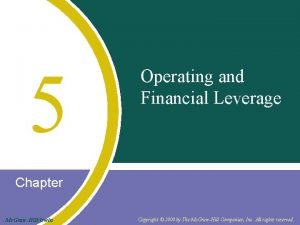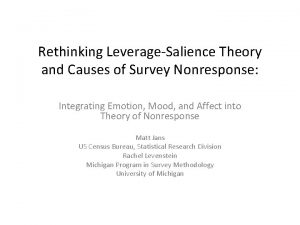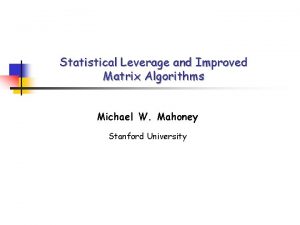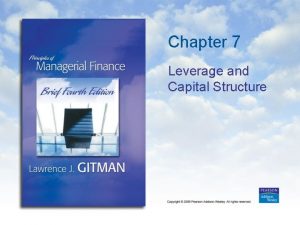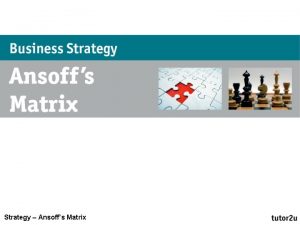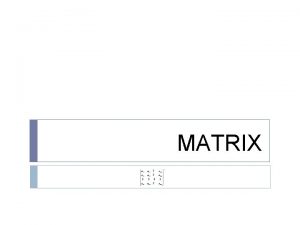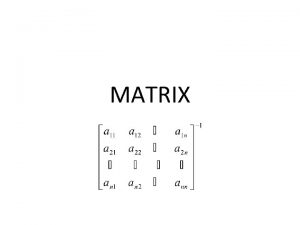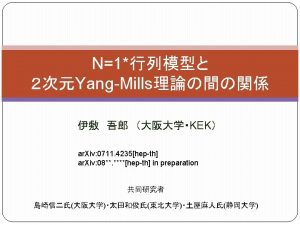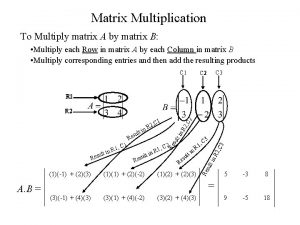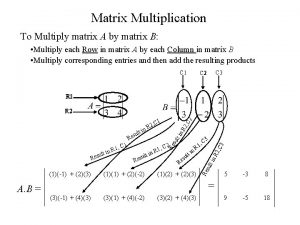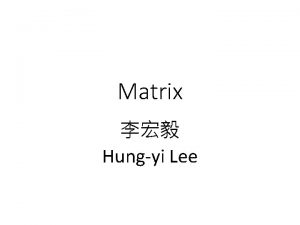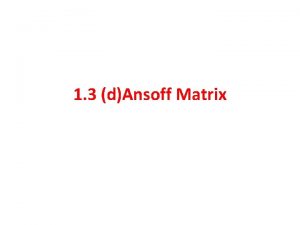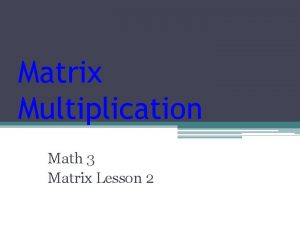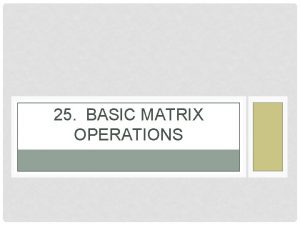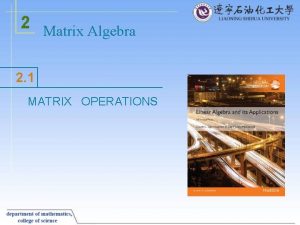Statistical Leverage and Improved Matrix Algorithms Michael W




























- Slides: 28

Statistical Leverage and Improved Matrix Algorithms Michael W. Mahoney Yahoo Research ( For more info, see: http: //www. cs. yale. edu/homes/mmahoney )

Modeling data as matrices NLA TCS SDA Matrices often arise with data: • n objects (“documents, ” genomes, images, web pages), • each with m features, • may be represented by an m x n matrix A.

Least Squares (LS) Approximation We are interested in over-constrained L 2 regression problems, n >> d. Typically, no x such that Ax = b. Want to find the “best” x such that Ax ≈ b. Ubiquitous in applications & central to theory: Statistical interpretation: best linear unbiased estimator. Geometric interpretation: orthogonally project b onto span(A).

Exact solution to LS Approximation Cholesky Decomposition: If A is full rank and well-conditioned, decompose ATA = RTR, where R is upper triangular, and solve the normal equations: RTRx=ATb. QR Decomposition: Slower but numerically stable, esp. if A is rank-deficient. Projection of b on the subspace spanned by the columns of A Write A=QR, and solve Rx = QTb. Singular Value Decomposition: Most expensive, but best if A is very ill-conditioned. Write A=U VT, in which case: x. OPT = A+b = V -1 k. UTb. Complexity is O(nd 2) for all of these, but constant factors differ. Pseudoinverse of A

LS and Statistical Modeling Assumptions underlying its use: • Relationship between “outcomes” and “predictors” is (approximately) linear. • The error term has mean zero. • The error term has constant variance. • The errors are uncorrelated. • The errors are normally distributed (or we have adequate sample size to rely on large sample theory). Check to ensure these assumptions have not been (too) violated!

Statistical Issues and Regression Diagnostics Statistical Model: b = Ax+ b = response; A(i) = carriers; = error process b’ = A xopt = A(ATA)-1 ATb H = A(ATA)-1 AT is the “hat” matrix, i. e. projection onto span(A) Note: H=UUT, where U is any orthogonal matrix for span(A) Statistical Interpretation: Hij -- measures the leverage or influence exerted on b’i by bj, Hii -- leverage/influence score of the i-th constraint Note: Hii = |U(i)|22 = row “lengths” of spanning orthogonal matrix Trace(H)=d -- Diagnostic Rule of Thumb: Investigate if Hii > 2 d/n

Overview Statistical Leverage and the Hat Matrix Faster Algorithms for Least Squares Approximation Better Algorithm for Column Subset Selection Problem Even better, both perform very well empirically!

An (expensive) LS sampling algorithm Drineas, Mahoney, and Muthukrishnan (SODA, 2006) Algorithm Theorem: 1. Let: 2. Randomly sample r constraints according to probabilities pi. Solve the induced least-squares problem. If the pi satisfy: for some (0, 1], then w. p. ≥ 1 - , pi are statistical leverage scores! U(i) are any orthogonal basis for span(A).

A structural lemma Drineas, Mahoney, Muthukrishnan, and Sarlos (2007) Approximate: by: any matrix. any orthonormal basis for span(A). Lemma: Assume that: Then, we get “relative-error” approximation:

A “fast” LS sampling algorithm Drineas, Mahoney, Muthukrishnan, and Sarlos (2007) Algorithm: 1. Pre-process A and b with a “randomized Hadamard transform”. 2. Uniformly sample 3. Solve the induced problem: constraints. Main theorem: • (1 )-approximation • in time!!

Randomized Hadamard preprocessing Facts implicit or explicit in: Ailon & Chazelle (2006), or Ailon and Liberty (2008). Hn = n-by-n deterministic Hadamard matrix, and Dn = n-by-n {+1/-1} random Diagonal matrix. Fact 1: Multiplication by Hn. Dn doesn’t change the solution: Fact 2: Multiplication by Hn. Dn is fast - only O(n log(r)) time, where r is the number of elements of the output vector we need to “touch”. Fact 3: Multiplication by Hn. Dn approximately uniformizes all leverage scores:

Overview Statistical Leverage and the Hat Matrix Faster Algorithms for Least Squares Approximation Better Algorithm for Column Subset Selection Problem Even better, both perform very well empirically!

Column Subset Selection Problem (CSSP) Given an m-by-n matrix A and a rank parameter k, choose exactly k columns of A s. t. the m-by-k matrix C minimizes the error over all O(nk) choices for C: Notes: • PC = CC+ is the projector matrix onto span(C). • The “best” rank-k approximation from the SVD gives a lower bound. • Complexity of the problem? O(nkmn) trivially works; NP-hard if k grows as a function of n. (Civril & Magdon-Ismail ’ 07)

Prior work in NLA Numerical Linear Algebra algorithms for the CSSP • Deterministic, typically greedy approaches. • Deep connection with the Rank Revealing QR factorization. • Strongest results so far (spectral norm): in O(mn 2) time (more generally, some function p(k, n)) • Strongest results so far (Frobenius norm): in O(nk) time

Working on p(k, n): 1965 – today

Theoretical computer science contributions Theoretical Computer Science algorithms for the CSSP 1. Randomized approaches, with some failure probability. 2. More than k columns are picked, e. g. , O(poly(k)) columns chosen. 3. Very strong bounds for the Frobenius norm in low polynomial time. 4. Not many spectral norm bounds.

Prior work in TCS Drineas, Mahoney, and Muthukrishnan 2005, 2006 - “subspace sampling” • O(mn 2) time, O(k 2/ 2) columns -> (1± )-approximation. • O(mn 2) time, O(k log k/ 2) columns -> (1± )-approximation. Deshpande and Vempala 2006 - “volume” and “iterative” sampling • O(mnk 2) time, O(k 2 log k/ 2) columns • They also prove the existence of k columns of A forming a matrix C, s. t. • Compare to prior best existence result: -> (1± )-approximation.

The strongest Frobenius norm bound Drineas, Mahoney, and Muthukrishnan (2006) Theorem: Given an m-by-n matrix A, there exists an O(mn 2) algorithm that picks at most O( k log k / 2 ) columns of A such that with probability at least 1 -10 -20 Algorithm: Use subspace sampling probabilities /leverage score probabilities to sample O(k log k / 2 ) columns.

Subspace sampling probabilities Subspace sampling probs: in O(mn 2) time, compute: These pi are statistical leverage scores! Vk(i) are any orthogonal basis for span(Ak). NOTE: The rows of Vk. T are orthonormal, but its columns (Vk. T)(i) are not. Vk: orthogonal matrix containing the top k right singular vectors of A. k: diagonal matrix containing the top k singular values of A.

Other work bridging NLA/TCS Woolfe, Liberty, Rohklin, and Tygert 2007 (also Martinsson, Rohklin, and Tygert 2006) • O(mn log k) time, k columns • Same spectral norm bounds as prior work • Application of the Fast Johnson-Lindenstrauss transform of Ailon-Chazelle • Nice empirical evaluation. Question: How to improve bounds for CSSP? • Not obvious that bounds improve if allow NLA to choose more columns. • Not obvious how to get around TCS need to over-sample to O(k log(k)) to preserve rank.

A hybrid two-stage algorithm Boutsidis, Mahoney, and Drineas (2007) Algorithm: Given an m-by-n matrix A and rank parameter k: • (Randomized phase) * Not so simple … Actually, run QR on the down-sampled k-by-O(k log k) version of Vk. T. Randomly select c = O(k logk) columns according to “leverage score probabilities”. • (Deterministic phase) Run a deterministic algorithm on the above columns* to pick exactly k columns of A. Theorem: Let C be the m-by-k matrix of the selected columns. Our algorithm runs in O(mn 2) and satisfies, w. p. ≥ 1 -10 -20,

Comparison: spectral norm Our algorithm runs in O(mn 2) and satisfies, with probability at least 1 -10 -20, 1. Our running time is comparable with NLA algorithms for this problem. 2. Our spectral norm bound grows as a function of (n-k)1/4 instead of (n-k)1/2! 3. Do notice that with respect to k our bound is k 1/4 log 1/2 k worse than previous work. 4. To the best of our knowledge, our result is the first asymptotic improvement of the work of Gu & Eisenstat 1996.

Comparison: Frobenius norm Our algorithm runs in O(mn 2) and satisfies, with probability at least 1 -10 -20, 1. We provide an efficient algorithmic result. 2. We guarantee a Frobenius norm bound that is at most (k logk)1/2 worse than the best known existential result.

Overview Statistical Leverage and the Hat Matrix Faster Algorithms for Least Squares Approximation Better Algorithm for Column Subset Selection Problem Even better, both perform very well empirically!

Tech. TC Term-document data • Representative examples that cluster well in the low-dimensional space.

Tech. TC Term-document data • Representative examples that cluster well in the low-dimensional space.

Conclusion Statistical Leverage and the Hat Matrix Faster Algorithms for Least Squares Approximation Better Algorithm for Column Subset Selection Problem Even better, both perform very well empirically!

Workshop on “Algorithms for Modern Massive Data Sets” (http: //mmds. stanford. edu) Stanford University and Yahoo! Research, June 25 -28, 2008 Objectives: - Address algorithmic, mathematical, and statistical challenges in modern statistical data analysis. - Explore novel techniques for modeling and analyzing massive, high-dimensional, and nonlinearstructured data. - Bring together computer scientists, mathematicians, statisticians, and data analysis practitioners to promote cross-fertilization of ideas. Organizers: M. W. Mahoney, L-H. Lim, P. Drineas, and G. Carlsson. NLA Sponsors: NSF, Yahoo! Research, PIMS, DARPA. TCS SDA
 How to calculate degree of operating leverage
How to calculate degree of operating leverage Statistical algorithms
Statistical algorithms Fast leverage matrix
Fast leverage matrix Fast leverage matrix
Fast leverage matrix Chapter 13 leverage and capital structure gitman ppt
Chapter 13 leverage and capital structure gitman ppt Operating and financial leverage
Operating and financial leverage Financial leverage and capital structure policy
Financial leverage and capital structure policy Business risk vs financial risk capital structure
Business risk vs financial risk capital structure Lift and leverage
Lift and leverage Degree of total leverage
Degree of total leverage Diagonal matrix properties
Diagonal matrix properties Inverse of transpose
Inverse of transpose Dissimilarity matrix in data mining
Dissimilarity matrix in data mining Orthogonal matrix example 3x3
Orthogonal matrix example 3x3 How to leverage edi
How to leverage edi Patrick wendell net worth
Patrick wendell net worth Muscles of the posterior leg
Muscles of the posterior leg High leverage point vs outlier
High leverage point vs outlier Basel 3 norms
Basel 3 norms Types of leverage
Types of leverage Cara menghitung dfl
Cara menghitung dfl Leverage ratio economics
Leverage ratio economics Rumus dol, dfl dcl
Rumus dol, dfl dcl Secondary brand associations examples
Secondary brand associations examples Homemade leverage example
Homemade leverage example Types of leverage
Types of leverage Leverage point in advertising
Leverage point in advertising Leverage percentage
Leverage percentage Leverage-saliency theory
Leverage-saliency theory

